TrekMovie had a chance to speak exclusively with Star Trek: Strange New Worlds co-showrunner Henry Alons Myers about Thursday’s series premiere and what comes next, covering issues ranging from Vulcan mating to new transporter tricks and more.
Being this is for TrekMovie.com, the questions are going to get a bit nerdy.
I wouldn’t have it any other way. I had thought I’m probably like a medium-level Star Trek nerd, and there are people who know a lot more than me. So I have a humble view of my own nerd-dom. And then I find myself correcting people like, “Oh, no, that’s not that’s not a Romulan ship. No, that’s not a this, that’s not a that.” I’ve sort of had this realization, “Oh, maybe I am a deep nerd and didn’t realize.” [laughs]
We like our writers and showrunners to be deep nerds, like Mike McMahan [Lower Decks], Terry Matalas [Picard], and Aaron Waltke [Prodigy].
I know Terry and Mike. I talk to Mike all the time and I talk to Terry all the time too. I am a big Lower Decks fan and we, Mike and I, bandy jokes around. All of us Star Trek showrunners know each other. I talked to Terry a lot, but I haven’t recently because he’s been buried in season three of Picard. There’s a lot of work.
Let’s start with the aptly named series premiere of Strange New Worlds. With so much talk about how this is a return to classic Star Trek, it still felt like a very modern show, especially with how you treat the characters. Is this your core difference from classic Trek?
One hundred percent. I would straight up say the thing that we borrow from Next Generation and Deep Space Nine and shows of that era is how they would iris in on different characters for each episode. Everyone’s in every episode, just about, but some focus on other people more. Like “Data’s Day” is one of our favorite episodes to talk about in the writers’ room. I loved how you have this great ensemble; like us, you want to use them. So it allows you to see different sides of the Enterprise and tell different stories and tell different experiences of it.
It was very important to me to do a Uhura episode really quickly on the heels of the pilot. The pilot is very much about Pike, and Uhura’s experience is exactly the opposite. She’s a cadet right now. Her experience on the Enterprise is the experience of being new to the Enterprise. She’s in a way like the audience. So that’s a big goal of ours, I would say.
It feels like you reveal more about these characters in the first five episodes than we learned about most characters in a season of Trek of that era. So are you trying to go beyond even Next Gen and DS9 with this kind of exploration and backstory?
Maybe. What we’re trying to do is like when you saw Star Trek: The Motion Picture in the movie theaters, as I did. If you saw The Original Series and then The Motion Picture, you were like, “Oh, they’re doing it bigger!” That’s a little bit what our mission is here. We’re doing a contemporary show with contemporary effects. Our designs are all built on the framework of the ‘60s stuff. But what if Gene Roddenberry did it now? He’d have a lot more money. He would probably want the costumes to look… you know they were using interesting, cool materials back then. It’s like a lot of mid-century modern stuff. Some of it looks timeless. Some of it looks cheap. But there are really cool elements in the design. We wanted to borrow that and suggest this is kind of what came before that.
We wanted to make it bigger. We want the effects to be bigger. We wanted our sense of the world to be bigger. We’re using this AR wall technology to create some of the worlds that we go to. It looks very different from going to a soundstage. No slight on the soundstage or the ‘60s or the time. If you look at Star Trek for its time, it was so expensive for a television show. But for our show, it’s just a different animal doing a show for a streaming service. We’re trying to make it look bigger and different. And that also includes approaching it with a contemporary sense of character. There’s a sophistication that today’s television audiences have that I think is different from the television audiences of the ‘60s. And we want it to look and feel like a show made today, but inspired by those shows of the past that we love.
Regarding contemporary things, the pilot had a very contemporary issue focus. Does the show have a point of view, and is it sending a message that you’re going to be tackling very contemporary issues head-on?
It is my opinion that Star Trek has always been a show that dealt with social issues and didn’t shy away from them. It goes right into the middle of them. I don’t think anyone does science fiction because they don’t want to talk about what’s happening in the present. Inevitably when you tell a story about the future, you’re making choices that suggest something about the present. That’s one of the things we love about Trek. We want that to be part of the show.
So, when does the second US Civil War start?
[laughs]
You have moved the Eugenics Wars into the 21st century, acknowledging they didn’t happen in the real ‘90s.
This is the hard thing about trying to be true to canon. Like the DS9 episode “Past Tense.” It’s weirdly prescient. It’s amazing how much they kind of get right. But yes, the Eugenics Wars were supposed to happen in the 1990s and most people’s experience was that is not what happened. You don’t want to get mad at reality for not comporting with Star Trek, but we sort of push things forward. A little bit of what we do in that is to suggest that… The message of the series pilot is we’re looking at a society where Pike essentially gives them a big choice at the end. You can choose to come together as a society and unify or you can choose conflict. And the conflict will inevitably lead to death.
All we’re doing in that is trying to tie in a little bit how that idea speaks as much to our society today as any other society. And maybe, for those who care deeply about the chronology of what Star Trek said in the past, the things that we are living now will lead to the stuff that we say happens. Which is as much as we can do, because we can’t control what happens in real life. [laughs] And as we go on, we are going to keep running into these dates.
Well, the Vulcans are going to show up in 40 years, so that one is fixed. So it might not be long until this Civil War starts.
[laughs] You know, I’m hoping Star Trek has it wrong about that. I really am. I will say that in a weird way, that’s kind of the purpose of this show. We’re trying to do a hopeful show. I’m not saying that bad things don’t happen. But I think one of the central notions of The Original Series was that in addition to having challenges, space holds hope for us. Exploration holds hope. That is something we wanted to carry into our series.
Another surprise is T’Pring and how much of her and Spock we actually see. What does this mean about exploring Spock and exploring what we know about Vulcan lore, including pon farr?
I’ve watched “Amok Time” many, many times. I’ve parsed the individual shots from certain sequences. And I have asked myself, “You know, if I squint…” I understand how I’m supposed to read that expression. But that expression is actually not necessarily telling me anything. And I could read it another way. So we tried as much as possible to make our T’Pring stuff comport with stuff that is to come. But we also want to tell a story about Spock now. Putting T’Pring in the pilot, frankly, gave us a chance to understand her as a character. I love writing for T’Pring. She’s super fun, and thoughtful, and interesting. We explore T’Pring a little more in the series, and part of that is about exploring Spock. And part of that is about deepening what we understand her to be. And part of that is about trying to delve into the Chapel relationship.
And if I’m not mistaken, D.C. Fontana scoffed at the notion that Vulcans only mated during pon farr. I also think one of the things that’s really fun about working with Spock now is like Spock in the ‘60s was an alien. He was the character who was different, and was “the other” on the show. Spock now is someone we know and understand in a deep way. Weirdly, for someone who is not outwardly emotional, he is a character who we can emotionally identify with. And I think it would be a mistake not to.
Do you want this show to be family-friendly and a show that can be watched with kids in the room?
Yeah. We’re trying to make a show for everybody. I will say that there are a few episodes that have some dark themes and some adult stuff. I have two sons, and I wanted to do a Trek show they could watch, although they watch all kinds of crazy stuff now because that’s what is on television. But I didn’t want that to be a barrier to entry.
Picard does a good job of being a show for adults. One of the things that I love is when I was working on the first season, I did a big rewatch of all of Deep Space Nine with my kids, which was a delight. And it held up very well. And one of the things I really enjoyed was how it dealt with the big adult themes, but you can watch it with anybody. It’s an eight or nine o’clock show, in the parlance of old-school television. We have a couple of episodes where I would say it’s like a nine o’clock show. Maybe there’s one that’s like a 10 o’clock show, But we’re trying to make a show that everyone can watch.
You had some fun with Trek technology, especially the transporter. After over 800 episodes of Trek, is it a challenge to come up with new ways to use these familiar elements, and especially deal with how no one has done this or that before?
We talk about that. But there’s no reason to believe that an infinitely configurable piece of machinery like a transporter can’t be used in a creative way that we haven’t thought of previously. We don’t want to deny where how it’s been used in the past. We just want to try to be a little inventive about it. There are times when we’re going to do that. That’s part of making a new show but it’s not a comment on the shows of the past. It’s more like us saying, “What if we tried this? Does it make any sense?”
There’s a moment in one of the early episodes where Spock reveals a defibrillator mode on the tricorder. It makes sense that it has it, perhaps we just have never seen one used like that on screen before. It’s hard when you’re doing a legacy property. Writers try to come up with a story and create tension and problems that help box them in. But you don’t want to box in future generations. So we sort of take it seriously, but not always literally.
You must always be running into developing stories you like but then run into something like “Oh, this is just like an episode of TNG,” or Voyager or whatever. Do you stop there or look how to…
No. We actually start by thinking about what are the genres that we want to try. Because we really are trying in every episode to really stretch the breadth of what we can do in Trek. So a lot of what we do is say, “What about this genre, what about that genre… What kind of movie are we trying to make?” And then we go see Trek did it with this and Trek did it with that. And we think about those ones and we look at those episodes and use them as sort of models and springboards and inspiration. And then we talk about how can push the boundaries of that. How can we try something bigger?
Trek has done funny episodes before. Trek has done scary episodes. Trek has done thrilling episodes. We’re trying to do what they did. But we’re trying to make it Star Trek: The Motion Picture, you know what I mean? We’re trying to make the bigger, contemporary version of it that pushes the boundaries of those things. We’re inspired by the Trek of the past, we’re not worried about copying it. We try hard not to. We like the Trek of the past. There are a million Prime Directive episodes. That doesn’t mean you can’t do another one. And this is the place where making it about the characters is what makes it specific. Because it’s about our people, now. That makes it specific. That’s the wonderful thing about doing a genre show. There are only so many different genre show ideas. Recycling them is okay, but making them about your characters and making it about now is what makes it specific and different. And that’s how we come at it.
More SNW interviews to come
We still have more gold carpet interviews from the New York premiere of Strange New Worlds with the cast and creatives. Check out our earlier interview with Henry Alonso Myers. Plus see our interviews with executive producer Alex Kurtzman, cast members Anson Mount and Rebecca Romijin, and Christina Chong.
New episodes of Star Trek: Strange New Worlds debut on Thursdays exclusively on Paramount+ in the U.S., Latin America, Australia and the Nordics. The series airs on Bell Media’s CTV Sci-Fi Channel and streams on Crave in Canada. In New Zealand, it is available on TVNZ, and in India on Voot Select. Strange New Worlds will arrive via Paramount+ in select countries in Europe when the service launches later this year, starting with the UK and Ireland in June.

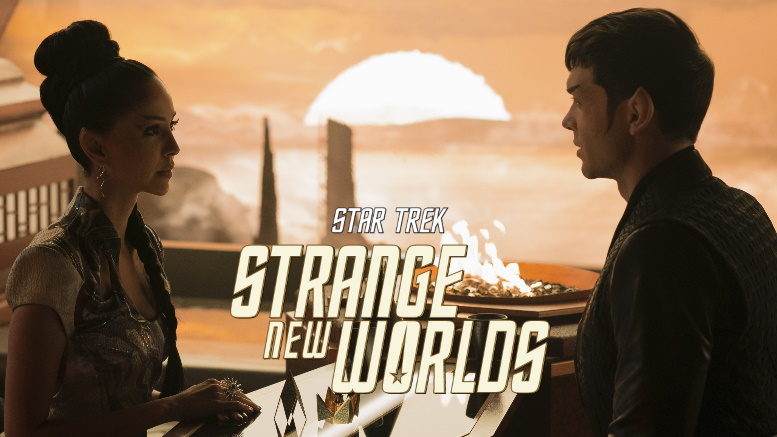
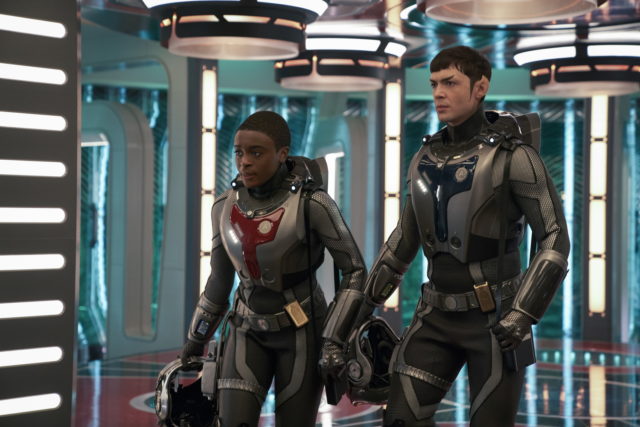
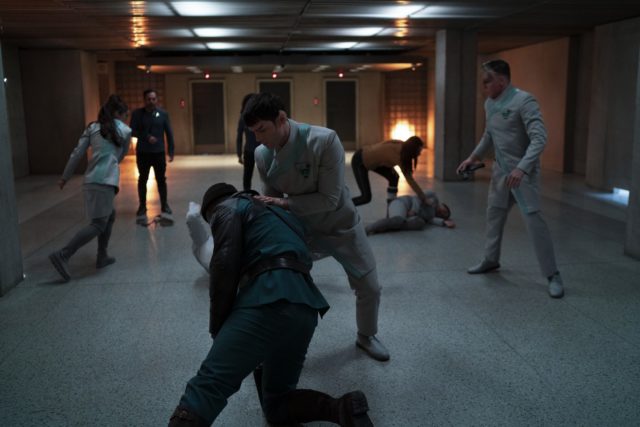
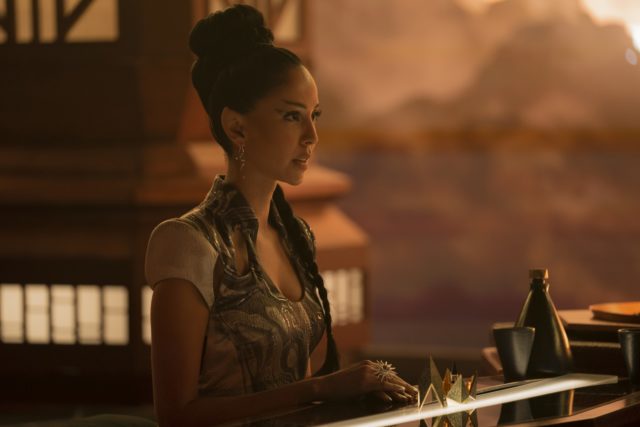
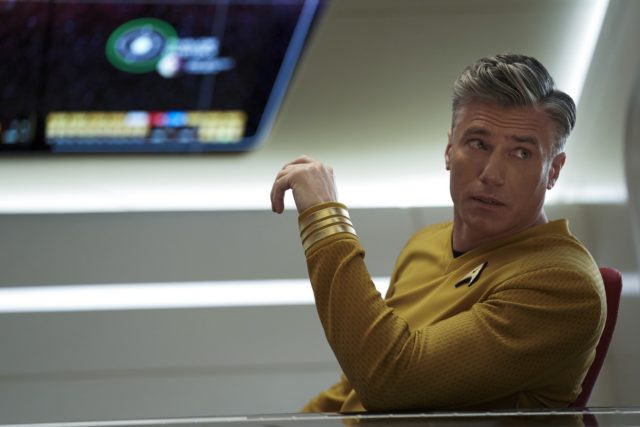

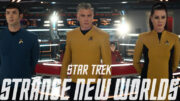


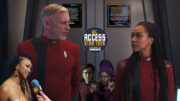
Excellent interview, as usual.
I’m a bit disturbed with this retconning of the Eugenics Wars. Especially because it feels like they want to use it more. Frankly, I don’t see the point of pushing an established date in the past to a near-future date that will also be outdated before long. (By the way, that’s exactly the reason why Roddenberry pushed Star Trek to a far future… to not bump into real history. Of course he never knew his creation would endure many decades, perhaps centuries, rendering almost all attempts at keeping “all in the future” futile…)
Instead of trying that again, I prefer to think that the fictional Earth history in Star Trek is different from our reality. As, of course, it is. There will be no crewed Europa Mission in 2024. You can be sure of it.
What I think they should do, if they want to play with those events, is to keep these events where they are, canonwise, but try and expanding the interpretation of what was said previously about them. Alas, that’s what I’m doing with the whole Pike speech, “what was called the Second Civil War, then the Eugenics War, and then Third World War.” Past Trek references on this are so obscure and confusing (Spock says the Eugenics Wars were our last major world conflict) that you can generate new interpretations that use the original references as springboards, giving a new meaning to them.
So, with Pike’s speech, for me, he’s talking about how future historians would address these events. And he’s saying something like, at first, they called it the Second Civil War, then Eugenics, then III WW. So, you can imagine there’s a period in Earth history that goes from the early 1990s to mid-21st century where many apparently different conflicts had common roots, what made historians group them, and use different successive names, reinterpreting what they felt was the best way to depict them for study purposes. This, to me, makes some sense. Not every country calls the same conflicts by the same name, and names that are now common were not in use at the time of said conflicts. Nobody called World War I as such back in the day…
I think this interpretation is still valid as of today, with Picard 201’s new clue about Khan. But the fact that they are mentioning it so much, across so many properties, and that they flerted with a Khan limited series before, tells me there will be more, and a definite retcon is coming. I think it is unnecessary, and unwarranted, but I’ll keep an open mind, if they go that way.
The infamous german dub from the 70s, which got many things wrong (they made his Pon-Farr being a “space-fever” and a dream), got it right with the eugenic wars and declared them happening in the 2090s.
You and I are, I think, in close agreement here. The retcon is not needed.
Great interview as usual Trekmovie!
I do think the show will win over people just by being classic Star Trek again. It’s pretty funny to me when people kept saying after Enterprise went off the air Star Trek has to move away from doing bumpy forehead alien of the week episodes as that format was tired out. And yet this episode is being praised for doing exactly that lol. This could’ve been a typical TNG, Enterprise or Voyager episode from 20+ years ago. It went back to basics in every way possible. Everything old is new again I guess. But it also proves end the day this is what the fandom mostly sees as Star Trek. They want to be on starships with 7 main characters solving a crisis for mostly humanoid aliens, doing a trippy time travel episode or running into crazy anomalies. They been conditioned to it after 50 years and 600+ episodes after all.
So I do think there needs to be ONE live action show that is doing this again. I don’t think people criticize Discovery or Picard for being ‘different’. It’s also for being not very good WHILE being different. And others think because it’s trying to do something different that is not really working for them as they should and I include myself in that.
I think SNW could be the best show in ‘NuTrek’. But I remember saying that about Picard as well. I will say here they do have all the basic elements many fans have missed at least and they are going to play on the nostalgia BIG TIME which will help a lot obviously.
Love that he mentioned it being more like TNG and DS9, that’s exactly how it felt to me, despite all the talk of trying to recapture TOS.
Me too! Another big example being TNG and DS9 were also ensemble shows, TOS wasn’t. They are (kind of) going back to the 3 main character format with Pike, Spock and Una; but every character here still gets their own individual episodes and back stories too. I mean we will probably learn more about this Uhura in the next five episodes than we learned about her in 3 seasons and six TOS movies which is a huge plus.
They are definitely not going back to the main three.
I have to say that it does bug me they opted to move Khan from the ’90’s to some point further in the future. Trek is not a history book. It has endured longer than they thought it would so these dates have come and gone. But those dates are still THEIR history. They should own it. Not move them because they didn’t happen in reality. That’s crazy. This is fiction. What are they going to do in 40 years when Vulcans don’t arrive?
You’re right. This is fiction. So it doesn’t matter.
I think there might be a connection to project Khan in PIC. I don’t believe it was a coincidence we saw references to Khan and the eugenic wars on two shows on the same day.
I totally adored the first episode of SNW. I’m not wild about their including T’Pring, though. In “Amok Time,” while they’re on the way to Vulcan, we see Spock looking at a picture of seven-year-old T’Pring, which strongly suggests that he hasn’t seen T’Pring since they were betrothed at the age of seven. And I like that about “Amok Time” because it feels so alien.
Having Spock and T’Pring “dating” makes both of them seem much more human. But I don’t want Vulcans to be human; Vulcans are interesting because they’re adjacent to humans but they AREN’T us, so they have a different perspective.
I watched Amok Time recently. Nothing says definitively that they haven’t seen each other since they were kids. If you want to lock your mind in a canonical jail cell, that’s your issue, not the showrunners.
End of the day, the stories are what matter not the little details anyway.
No, we’re supposed to make inferences from the things we’re shown. It’s the sort of thing people do with fiction.
I also explained that it isn’t a slavish attention to canon but rather a desire that Spock NOT be made too human that drove my opinion. Getting the details nailed down doesn’t matter, but keeping Spock Vulcan DOES.
It is true that we are supposed to make inferences. But when shown multiple things, our inferences in a supposedly consistent shared universe must account for all of them, not just the first, or even the favorite…
I suppose this is gonna be the backstory for Amok Time and explain why T’Pring changed her mind after waiting so long for Spock. Spock is torn between duty and family, but we know that his duty outweighs. Therefore it fits.
What didn’t fit IMHO is how human they behave in the vulcan public. Kissing in the vulcan public? Shouldn’t that be a veeeeeery big taboo there?
Well they were asked to leave and he hasn’t completely repressed his human half yet.
And in TOS, the way Vulcan’s expressed affection in public was touching fingers, not kissing. I agree with you.
This. They both knew they were in public. The finger thing seems to be a socially acceptable sign of affection. That is what they should have done. Although we wouldn’t have gotten the joke for them to do that elsewhere. Perhaps that was the point? Just to get the joke in?
The defibrilating tricorder sounds like something they remembered seeing in CASINO ROYALE, where Bond’s car seems to be able to provide a cure for every poison short of what you might experience with Horta culture.
Given that Picard apparently had a HomeAlone/Skyfall type sequence recently, I’m guessing the writers are showing their influences … and those are definitely not thrilling me at all. Steal from good stuff, not from some grossly overrated mess that seems to be about a secret agent who just goes around collecting leads by killing agents for secret cellphone data that in real life they’d keep in their heads.
Casino Royale or even much further back – when the 1960’s Batman and Robin would be able to access a new Bat-gadget of one kind or another to get themselves out of any fix. But…that was meant to be funny (and was) because Batman in those days was a campy comedy. SNW should not indulge itself in cheap gimmicks; it begins to wear on the ‘suspension of disbelief’ which any fictional work depends on.
Well, if the tricorder is going to be their version of a swiss army knife (or a smart phone, which I guess is a better analogy), maybe we’re going to have to get used to them using it to macgyver their way out of jams. TOS did some weird stuff with the equipment sometimes, but it usually felt vaguely credible, like when the two communicator superheterodyned (or whatever) and brought down a mountain in FRIDAY’S CHILD.
The tricorder having a defibrillator mode seems perfectly credible to me
Watching a beautiful Vulcan woman making herself available to Spock, and having him turn it down in favor of duty…..knowing how that story ends — was pretty heartbreaking.
I’m a fairly decent canon guy and I had no issues with showing T’Pring here. My only thing was it makes Spock staring at her childhood photo a little more creepy but that’s all.
Rotten Tomatoes gave Strange New Worlds the perfect score of 100.
Yeah, and a 92% audience score. Discovery is currently at 36% in that category…but it can take heart that it’s beating Star Trek V: The Final Frontier by 11 points!!!
My personal mini-retcon to get by the 1990s issue was that the Eugenics Wars were a secret, clandestine affair. Teams of covert special forces (made up of augments), locked in a hidden war between nations and factions. Influencing world affairs/politics.
I didn’t see it as a full on hot war type of scenario. We know R&D military tech is years more advanced than anything we have at the time, hence the Botany Bay. Maybe all the temporal incursions allowed these groups to gather data/reverse engineer tech so it was far more advanced. Maybe WWIII was a result of nations finding out augments were used to influence world events etc.
I could get behind this!
This was what the Trek powers that be were saying in the 1990s.
And First Contact put WW3 decades in the future.
Nothing new here actually.
It seems as though some here would like to decanonize anything about that from TNG.
Agreed – that’s always been my assumption as well. The Eugenics Wars (in our time) may not even be referred to as such. It could be a name applied by later generations to current conflicts, who have a more complete picture of events “behind the scenes” than we do.
I like the interpretation of whoever updated the Memory Alpha Eugenics war page. Their interpretation is that the Eugenics wars happened in the 1990s as always stated. Then the 2nd civil war (still not enthused about that) led into essentially a 2nd eugenics war which was eventually called world War III. That is my head cannon.
This can also work for me.
This was the interpretation of Greg Cox’ novel series “The Eugenics Wars.” All the brushfire wars of the 1990s that happened in real life were actually part of the secret wars between Khan and the other augments. Haven’t read it myself, but it seems like a nice way to have the Eugenics Wars happen in their canonical time while still jiving with our real-world history. And it doesn’t negate the possibility for a second round of such wars to happen again in the 21st century as Pike states.
I wish they’d hold off/slow down on the everyone has a dark trauma in their past stuff. It gets old and it’s a distraction. I don’t want it as an A story every week.
Translation: “I want outdated cookie cutter characters like those from my childhood”
“Star Trek: The Motion Picture in the movie theaters, as I did. If you saw The Original Series and then The Motion Picture, you were like, “Oh, they’re doing it bigger!” ”
<—- Like x 100000
RIGHT. It’s space exploration, colonization, the final frontier… Horatio Hornblower in space. One ship, one crew can decide the fate of humanity, species, who lives, who die, etc.
“Like “Data’s Day” is one of our favorite episodes to talk about in the writers’ room.”
WRONG.
I don’t know why they keep trying to force a TNG connection when that just leads to nonsensical time loops, boring holodeck episodes and canon complaints. If we wanted bland comedy we’d watch Orville.
It’s mutually exclusive!!!
Can already see Prodigy is going from kids finding their way in the galaxy to falling apart with a time loop that makes no sense and canon characters kids don’t get nor care about (two Janeway’s, etc). Ugh.
Stop. It. I know you want to relive being ten, but Time Trek The Technobabble Generation sucked holodeck then, and it sucks now.
The success of SNW is TMP, TOS, etc. Not TNG. Hell, incorporate DS9 if you want some 90s Trek so bad.
Everyone’s a critic
As far as I’m concerned, the Eugenics Wars dates as established are still locked in. Trek is alternative history, as every space adventure show that lasts long enough in cultural memory will become. I have no problems accepting this, and I see that I am not alone in that acceptance. The DY-100 was neither built by nor for the US, so it didn’t show up in the Europa Mission PR display. And Adam Soong…probably was very poorly inspired by the Eugenics Wars as a twenty-something research student.
As for this Second American Civil War…well, it’s probably been going on since the 1960’s and just didn’t get recognized as such until after the fact.
Yes, the historians living in that universe are going to argue over what happened when and what it all meant and means as the centuries pass.
I think I understand what Henry Alonso Myers is saying about the dates in Star Trek. I think the idea they’re going with is that the Eugenics Wars happened and are happening now. I believe he’s trying to say that in the Star Trek universe, Khan is responsible, behind the scenes of course, for all the division and strife that is tearing the world apart right now, which is basically what happened during the original years for the Eugenics Wars. Instead now it’s been bumped up into the 2000s and not the ’90s.
So the same event does take place in the Star Trek universe, just in a more modern frame of time. That makes sense to me. I mean he’s not saying that the Eugenics Wars never happened and that’s really the important thing, right? But part of me says, why mess with it at all, right?
Let’s play devil’s advocate now. Henry Alonso Myers stated that people are telling him that they lived through the ’90s and nothing like the Eugenics Wars ever happened. Now there’s the problem right there because you’re blending fact with fiction. The Earth in Star Trek is not our Earth, it’s a vision of what our Earth could become if we set aside all the strife, division, and hate.
It is a fictional Earth. So being as the Earth in Star Trek is a piece of fiction then so too can it’s history be. Which means the Eugenics Wars could take place in the ’90s, the Bell Riots in 2026, WW3, etc etc. They could all happen when they’re supposed to happen because the Earth in Star Trek is its own Earth with its own history.
They’re trying to blend fact with fiction and that’s where they’re going to have problems. Of course we never experienced anything like the Eugenics Wars because it’s not our Earth. On the Star Trek Earth, they did. It represents a very big mistake made by the scientists of the Star Trek Earth.
A mistake involving genetic engineering. That’s why it’s banned throughout the Federation. It allowed people with superhuman strength and intellect to rise to power too fast. But that’s a mistake that was made on the Earth in Star Trek, not our Earth.
And it shouldn’t be confused as such and that’s where and why they’ll run into problems with Star Trek’s history. Because they’re treating the history of the Earth in Star Trek as if it was our own and it’s not. They should just be concerned with telling a good story set in the Star Trek universe. Also, I must say that what Henry Alonso Myers said about the tricorder being used as a defibrillator sounds pretty cool and I can’t wait to see that!
I loved how they used the transporter to beam Spock’s booster inside of him that was pretty cool! Live long and prosper, Trekmovie 🖖
Here is a thought…. don’t set it on Earth in the 90, 2020s and don’t do time loops that make no sense. Last I check the show was called STAR Trek. Leave the I suppose hateful people that don’t go back in time to save everyone in WW2 with anti science technology when they could to a not so well thoughtout episode of TOS and Time Trek: The Technobabble Generation.
I too am tired of time travel stories but it’s Star Trek and that’s it’s bread and butter. The minute a descendant of Khan’s was put on the Enterprise, especially on the bridge, that should’ve been a BIG indication that we’re gonna be seeing Khan on SNW. They wouldn’t be messing with the Eugenics Wars if we weren’t going to be seeing it on screen soon and the only show that could come close to having a reasonable reason for showing the Eugenics Wars finally is SNW because of La’an. I really don’t want more time travel myself because everytime they do it the timeline gets more and more messed up.
But as long as Alex Kurtzman is still the show runner than we’re gonna have time travel in Star Trek and lots of it. Live long and prosper, Cmd.Bremmon 🖖.
Regarding when the Eugenics Wars happened, I think the dates of these wars depend on which calendar was used. On one calendar, these conflicts happened in the 21st Century (2026-2053?), but on a different calendar, the wars happened in the 1990s (1993-1996?).
“Space Seed” itself hinted at two different calendars used during the wars: As we know, Spock said, “The mid-1990s was the era of the last so-called World War,” which McCoy subtitled as the Eugenics Wars. In addition, he, Kirk, Scott, and McGivers dated the Botany Bay, Khan, and his people to the 1990s and the Twentieth Century.
However, Kirk gave an estimate of two centuries for how long Khan, and by extension his people, had been sleeping; and Scott said they were apparently in suspended animation when the ship took off. According to the Memory Alpha website, the in-universe date of the episode was 2267. This would mean that the Eugenics supermen took off from Earth circa 2067. So circa 2067 on one calendar was 1996 on the other.
So, the Vulcan science officer who endeavors to be accurate may not have been wrong after all.
In any case, the Federation principally measured time in Stardates, not dates on old calendars.
Incidentally, Stardates look like Julian Day Numbers. If the date of June 7, 1996 shown on the Project Khan folder was a Gregorian date, then the corresponding Julian Day Number would be 2450242 (https://core2.gsfc.nasa.gov/time/julian.html).
Since the Eugenics Wars/World War III did not happen in the mid-1990s of reality, then the dates of the 1990s and the 20th Century for these wars as well as for the Botany Bay and the Eugenics supermen were not dates on the Gregorian calendar, but dates on the other calendar, perhaps, a calendar established by the one of the post-Hitler tyrants mentioned in Star Trek – Ferris, Maltuvis, Lee Kuan, Krotus, Green, or even Khan himself.
The “doing it bigger” of TMP had in-universe explanations that were explicitly stated or can be logically inferred: The Enterprise was refit, the rest of Starfleet and the Klingon fleet were also modernized, and the Klingons themselves either found a cure that reversed the Augment-modified Levodian Flu virus or all underwent cranial reconstruction.
And of course, the alternate reality of Star Trek (2009) was explained by Nero’s attack on the Kelvin.
Could there be in-universe explanations for “doing it bigger” in DSC and SNW?